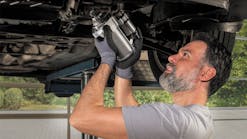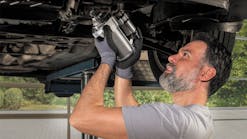The 4EAT transmission (Figure 1) used in Subaru vehicles has been out on the road in many parts of the world as early as 1987 to as late as 2012. Throughout those years, the transmission has been through many significant changes. The first main change occurred in 1998 where the 2-4 brake band with replaced with a 2-4 clutch pack (Figure 2). The valve body went from using five solenoids to seven solenoids (Figure 3).
This caused an additional dropping resistor to be added to the electrical system: one for line pressure control as was with the early design and now one added for the 2-4 Clutch Duty Solenoid (Figure 4). Because these resistors are used in these solenoid’s electrical circuit, when they fail they can cause harsh or flared shift complaints. Vehicles with all-wheel drive (AWD) have a transfer clutch solenoid and valve body assembly that went from being located in the rear drive shaft housing to the rear of the transmission (Figure 5).
This change is identified by calling the first design the 4EAT Phase 1 and the second design the 4AT Phase 2. An interesting point regarding this change is that the Phase 1 design used a powerflow, the same as a Nissan Pathfinder rear wheel drive transmission called the RE4R01A. Phase 2 uses the same powerflow as Nissan Maxima’s front wheel drive RE4F02A transmission. The forward clutch in Phase 1 remained applied in all forward ranges, while in Phase 2 it is released in fourth gear. This also is why the forward clutch in Phase 1 is referred to as the Low Clutch in Phase 2. The outer piston seal (Figure 6) of this clutch drum (Figure 7) is known to flatten, causing delayed Drive engagements as well as a flare during 4-3, 4-2 kick-down maneuvers.
There is an interesting solenoid cross connect that can occur easily. Looking at the photo in Figure 8, you will see a pink solenoid and a gray solenoid side by side. The connector with the orange wire plugging into the pink is the pressure control solenoid. The gray wire connector plugging into the gray is the low timing solenoid.
Normally, the low clutch timing solenoid acts as a reverse inhibit solenoid should reverse be selected while driving forward. It’s a safety feature. The pressure control solenoid, however, controls line pressure. This means it is fully pulsed during initial start-up to lower line pressure for a smooth controlled garage shift into gear. When these two solenoids are cross-connected accidently, a no-reverse condition occurs as the low clutch timing solenoid is being turned on when it shouldn’t be. Of course if the low clutch timing solenoid has mechanically failed, it can produce the same complaint.
One quick way you can determine if the low clutch solenoid has been cross-connected with the pressure control solenoid is to keep the selector lever in reverse and turn the ignition off. The transmission suddenly will lurch into reverse before the engine has a chance to shut down. This typically will not work if the solenoid is mechanically bad, as it will continue to hold pressure until the pump stops turning when the engine is off.
Another area to watch for is the eyelet ground that you can see in the same photo just below the pink solenoid. This is the main ground path for all the solenoids and the TCM. You can imagine the issues that will arise should this eyelet ground be compromised by tightening the bolt with an impact gun.
Figuring out the Fuses
As mentioned earlier, vehicles equipped with the AWD feature is controlled by the transfer clutch solenoid seen in Figure 5. When this solenoid is turned off, it engages a transfer clutch in the rear drive shaft housing (Figure 9). This clutch then supplies torque to the rear wheels through a drive shaft. During turns, this solenoid is duty cycled on to control the release of the rear wheels preventing what is described as “wheel hop.” In other words, if the clutch remains fully applied at all times, especially in turns, there becomes a drive line wind up causing a bind in the gear train. The wheels then are forced to skip so as to release this stress. This is not to be confused a tight feeling when making slow turns getting in and out of a parking spot. That is normal. What is not right is when the wheels actual actually skip, chatter or hop, doing the crab walk.
There are many reasons for this condition to occur. Externally, it can be due to an ABS problem or tire size issues. It also can be that the rear differential was replaced with the wrong ratio. Likewise, someone could have exchanged the transmission with the wrong front differential ratio. Both front and rear differentials must have matching ratios. This error usually will cause wheel hop going straight down the road and does not need to be in a turn.
One quick way to determine if there is an external problem causing this complaint is to insert a fuse into an FWD fuse holder. This can be located independently near the firewall or shock tower in the engine compartment or in the fuse box (Figure 10). The independent fuse holder will have a cap with the letters FWD on it (Figure 11). The inside fuse box cover will identify the FWD location as well (Figure 12).
By inserting this fuse, the transfer clutch solenoid is being turned on to release the transfer clutch. If it does release the clutch and the wheel hop condition is alleviated, confirmation is made that an external control problem is the cause, especially if the ABS light is lit (Figure 13). If the problem remains, the solenoid has mechanically failed or the transfer control valve is stuck in the applied position or the clutch pack itself is seized. Should this clutch assembly (Figure 14) need servicing, Subaru has a bulletin (No. 16-64-99) that provides the following instructions:
In the past, when performing the transfer clutch overhaul, the friction and steel plates were sold as a set. The selective pressure plate used to set the clutch pack end clearance was ordered individually as a separate component. Now, when replacement of the transfer clutch is necessary, you will need to measure the thickness of the end plate that is being removed from the worn clutch pack (3.3, 3.7, 4.1, or 4.5 mm) and order the appropriate clutch pack assembly based on the chart shown in Figures 15 and 16.
When installing the new clutch pack, do not disassemble it to soak the friction plates prior to installation as in the past. Some ATF should be used during assembly for lubrication purposes. It is important that the new plates be kept in the order that they are shipped as they are “broken in” during the manufacturing process prior to packaging. After installation into the clutch drum, make sure the end clearance measurement is within the proper specification as outlined in the Service Manual or repeat the above procedures until the proper clearance is obtained.
Subscribe to Motor Age and receive articles like this every month…absolutely free. Click here













.jpg?auto=format,compress&fit=max&q=45&w=250&width=250)
.jpg?auto=format,compress&fit=max&q=45&w=250&width=250)



